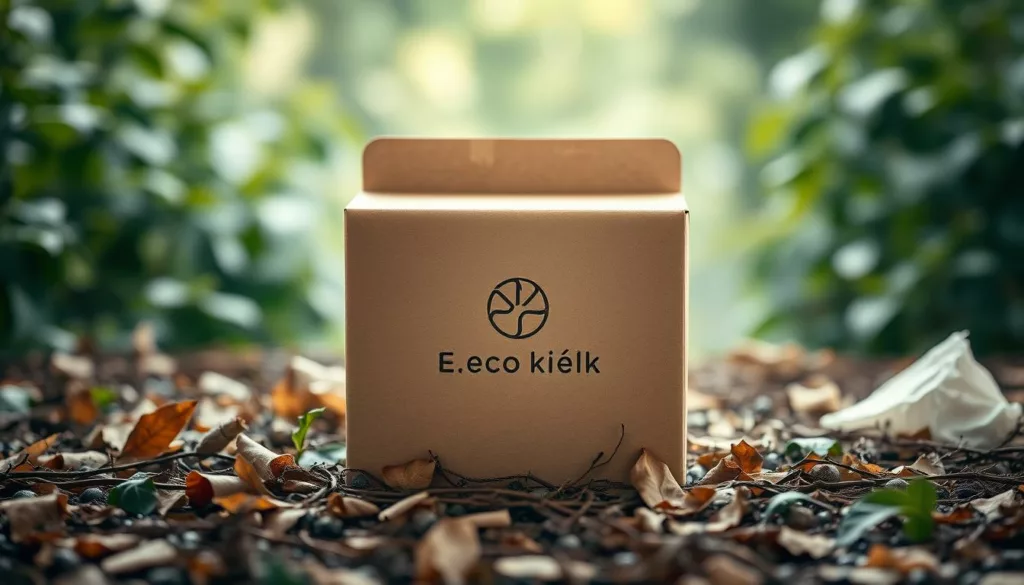
Are eco-friendly practices just a trend, or are they here to stay? With 85% of consumers now choosing online stores that care about the planet, it’s clear that environmentally-conscious communication matters a lot.
This change in how people shop shows that e-commerce brands need to change too. By focusing on being green, businesses can help the planet and also make their brand reputation stronger. This appeals to more people who care about the environment.
Key Takeaways
- Consumers are driving the demand for eco-friendly e-commerce practices.
- Adopting an eco-conscious communication strategy can enhance brand reputation.
- E-commerce businesses must adapt to the growing demand for sustainability.
- Environmentally-friendly branding approaches can lead to increased consumer loyalty.
- Embracing sustainability is crucial for long-term business success.
The Evolution of Green Consumerism in Digital Retail
The digital retail world is changing fast. More and more people want to buy from brands that care about the planet. They look for eco-friendly options when they shop online.
People are now more aware of environmental problems. They want to live more sustainably. E-commerce businesses are starting to use green practices. They choose sustainable materials and cut down on packaging.
The Growing Demand for Sustainable Products Online
A big number of people, 73%, say they’d change their buying habits to help the environment. This shows a big need for green products. Online stores are answering by selling eco-friendly items and talking about their green efforts.
This trend isn’t just for certain products. It’s for everything from clothes to home items to personal care. Buyers want products that are good for the planet and made fairly.
How Sustainability Drives Consumer Loyalty and Conversion
Ethical brand storytelling is key to winning over customers. Brands that share their green efforts build trust. This makes people feel connected to the brand.
This connection can make people loyal and more likely to buy again. When values match, customers become brand advocates. Conscious consumer messaging that speaks to people’s values can boost a brand’s green image.
Fundamentals of Sustainable Brand Messaging
The rise of green consumerism has made sustainable brand messaging key to winning customer loyalty. Today, people want brands that offer eco-friendly products and share their green efforts. This is crucial for building trust and loyalty.

Defining Your Brand’s Unique Sustainability Proposition
Having a unique sustainability proposition helps your brand stand out. It’s about clearly showing your commitment to the environment and how you’re making a difference. To craft this proposition, think about these steps:
- Identify your brand’s core sustainability values
- Assess your current environmental impact
- Set clear, measurable sustainability goals
By defining your unique proposition, you create a story that eco-conscious consumers will love. This sets your brand apart from others.
Avoiding Greenwashing: Building Authentic Communications
Being authentic is crucial for sustainable brand messaging. Greenwashing, or making false claims about environmental benefits, can hurt your reputation. To avoid this, focus on:
Common Greenwashing Pitfalls to Avoid
- Making unsubstantiated claims about environmental benefits
- Using misleading labels or certifications
- Highlighting minor environmental achievements while ignoring larger impacts
Creating Verifiable Sustainability Claims
To gain trust, back up your claims with solid evidence. This includes:
- Third-party certifications and audits
- Transparent reporting on environmental performance
- Clear information about sustainable practices and initiatives
A sustainability expert says, “Transparency is the foundation of trust. Brands must share their achievements and challenges to build credibility.” By following these tips, e-commerce brands can create a strong sustainable messaging strategy. This will resonate with consumers and build long-term loyalty.
Establishing Your Brand’s Eco-Friendly Foundation
A brand’s path to sustainability starts with a solid eco-friendly base. This base is key for making a real environmental difference. It also helps build a brand that eco-aware customers will love.
Conducting a Sustainability Audit of Your Business
Starting with a sustainability audit is vital. It helps understand a brand’s environmental footprint. This includes looking at the supply chain and packaging.
By spotting areas to improve, brands can lower their environmental harm. A detailed audit shows where a business stands now. It points the way to greener practices.

Setting Meaningful Environmental Goals
After the audit, brands should set clear environmental goals. These goals might be to cut carbon emissions or reduce waste. They should be reachable yet impactful.
Setting these goals helps businesses focus on real sustainability improvements. It makes their efforts count.
Developing a Sustainability Mission Statement
A sustainability mission statement guides a brand’s green efforts. It shows the brand’s dedication to the environment. It also explains how it plans to reach its eco-goals.
A good mission statement motivates everyone inside and outside the company. It builds a culture of sustainability.
By taking these steps, e-commerce brands can build a strong eco-friendly base. This base is crucial for a brand’s sustainability journey. It supports an effective eco-conscious strategy and positive environmental impact.
Crafting an Eco-Conscious Communication Strategy
Nowadays, 68% of people are willing to spend more on products that are good for the planet. Creating an eco-friendly communication plan is key for any brand. It helps build a strong image in a world that cares about the environment.
Ethical Brand Storytelling Techniques
Ethical brand storytelling means being real and open. It’s about sharing how your brand works to be green. Storytelling helps connect with people, making your brand seem more real and trustworthy.
- Highlight customer testimonials who appreciate your sustainability efforts.
- Share behind-the-scenes content showcasing your green initiatives.
- Use narrative techniques to make your sustainability goals more engaging.
Visual Design Elements That Communicate Sustainability
Visuals are important for showing your brand’s green commitment. This includes eco-friendly packaging and sustainable materials in your products. 
Some good visual design elements are:
- Using natural colors and earthy tones in branding.
- Incorporating imagery that reflects nature and sustainability.
- Designing packaging that is minimal, recyclable, or biodegradable.
Language and Terminology for Green Marketing
Green marketing language should be clear and consistent. It’s important to avoid greenwashing and be truthful about your efforts to be more sustainable.
Industry-Specific Sustainability Terms
Using specific terms from your industry can make your brand seem more credible. For example, in fashion, terms like “organic cotton” and “recycled polyester” are important. Keeping up with these terms shows your brand’s dedication to being green.
Creating an Accessible Green Vocabulary
Not everyone knows the latest green terms. It’s good to explain technical words and acronyms. This makes your green efforts clear to more people.
By using these strategies, online stores can share their eco-friendly efforts. This builds trust and loyalty with customers who care about the planet.
Implementing Sustainable Brand Messaging Across Digital Touchpoints
With 45% of consumers expecting sustainability in everything they buy, e-commerce brands must show their eco-friendly side online. This means using green messages on product pages, in emails, and on social media.
Optimizing Product Pages with Sustainability Information
Product pages are key for sharing green messages. Brands should clearly display how their products are eco-friendly. This could be through materials used, energy saved, or recyclable packaging.
Brands can add dedicated sections on product pages for green features. Or, they can use eco-labels next to product images. This makes shopping better and shows the brand cares about the planet.

Creating Eco-Focused Email Marketing Campaigns
Email marketing is great for reaching customers and promoting green living. Brands can highlight their green efforts, share eco-tips, or offer deals for sustainable choices.
For example, a brand might send a “Green Tips” newsletter every month. It could include product suggestions, environmental news, and special deals for green products. This builds loyalty and shows the brand is a leader in sustainability.
Social Media Strategies for Environmental Advocacy
Social media is a powerful tool for spreading environmental messages and showing off green practices. Brands should use platform-specific approaches to connect with their audience.
Platform-Specific Approaches
Each social media platform is different. Instagram is great for showing off eco-friendly products or behind-the-scenes looks at green manufacturing. Twitter is perfect for quick tips or environmental campaigns due to its short format.
Engaging with Eco-Conscious Communities Online
Connecting with green communities online is key for building trust and loyalty. Brands can do this by joining in on discussions, sharing customer eco-friendly moments, and hosting webinars or Q&A sessions on green topics.
By using these strategies online, brands can share their green commitment, engage with customers, and grow their business in an eco-aware market.
Building Consumer Trust Through Transparency
Transparency is key to winning trust from eco-conscious consumers today. They want more than just green promises from brands. They need proof of real sustainable actions.
Brands must share their journey, including both wins and setbacks, to be transparent.
Showcasing Your Sustainable Supply Chain
Showing off your sustainable supply chain is a great way to be open. This means sharing details on where materials come from and how they’re made. Brands can talk about working with green suppliers or how they cut down on waste.
Leveraging Third-Party Certifications and Standards
Using third-party certifications like Fair Trade or LEED is another smart move. These stamps of approval prove a brand’s green claims are true. Displaying these on products and ads shows a brand’s dedication to being eco-friendly.
Communicating Both Progress and Challenges
It’s also vital to talk about both successes and hurdles in going green. This shows a brand is serious about getting better and facing tough issues head-on. For example, a brand might share how it’s cut carbon emissions while discussing the hard parts of finding sustainable materials.
By being open and honest, e-commerce brands can improve their green image. This builds a stronger bond with customers who care about the planet.
Measuring the ROI of Sustainable Brand Messaging
As more people care about the planet, it’s key for online stores to see how green marketing works. Knowing how eco-friendly messages help the business is important. It helps show why spending on green practices and marketing is worth it.
Key Performance Indicators for Green Marketing Initiatives
To really know if green marketing pays off, businesses need to watch certain signs. These signs include:
- Website traffic and how people interact with it
- How many people buy eco-friendly products
- How well customers stick around and join loyalty programs
- How much people talk about the brand on social media
By keeping an eye on these signs, companies can see how green messages change how people act and help the business grow.
Analytics Tools for Tracking Sustainability Messaging Impact
There are many tools to see how green messages affect people and the business. Some of these tools are:
- Google Analytics for website stats
- Tools for social media to see how people interact
- Software for email marketing to check how campaigns do
Using these tools, businesses can learn more about their green marketing. This helps them make their messages even better.
Conversion Metrics for Eco-Conscious Consumers
It’s important to watch how well green messages sell to people who care about the environment. This means looking at:
- How many people buy green products
- The average amount spent on eco-friendly items
- How often customers come back after seeing green messages
These numbers show if green marketing is making sales and keeping customers happy.
Measuring Brand Perception Changes
Seeing how people view the brand is also key. This can be done by:
- Asking customers what they think
- Looking at what people say on social media
- Using tools to track what people say about the brand
By watching these, companies can see how green messages change how people see the brand and stay loyal.
Success Stories: Leading Sustainable E-commerce Brands in America
American e-commerce is leading a sustainability revolution. This is thanks to brands that focus on eco-friendly practices. These brands are changing their businesses and setting new standards for the industry.
Patagonia: Environmental Activism as Brand Identity
Patagonia is a leader in environmental activism. They use recycled materials and support fair labor practices. Patagonia’s commitment to sustainability is clear in their supply chain transparency and activism.
Their efforts have reduced their environmental impact. They have also built a loyal customer base that shares their values.
Allbirds: Transparent Carbon Footprint Communication
Allbirds is known for their comfortable and sustainable footwear. They provide detailed information on the environmental impact of their products. This transparency builds trust with their customers, who value sustainability.
Grove Collaborative: Scaling Sustainability in Household Products
Grove Collaborative has made household products more sustainable. They offer eco-friendly cleaning and personal care products. Their subscription model ensures sustainable products are delivered regularly, promoting a sustainable lifestyle.
Thrive Market: Accessibility and Sustainability Combined
Thrive Market offers healthy and sustainable products at affordable prices. Their membership model makes sustainable choices more accessible. By democratizing access to sustainable products, Thrive Market is crucial in expanding the market for eco-friendly goods.
| Brand | Sustainability Initiatives | Impact |
|---|---|---|
| Patagonia | Supply chain transparency, environmental activism | Reduced environmental footprint, loyal customer base |
| Allbirds | Transparent carbon footprint communication | Built trust with customers, increased brand loyalty |
| Grove Collaborative | Eco-friendly household products, subscription model | Promoted sustainable lifestyle, consistent customer engagement |
| Thrive Market | Accessibility to sustainable products, membership model | Expanded market for eco-friendly goods, affordable sustainability |
Conclusion: The Future of Sustainable E-commerce Branding
The future of e-commerce is all about being green. More and more people want brands to care about the planet. Making a brand message that’s all about being eco-friendly is key to doing well online.
When e-commerce sites focus on being green, they win over customers. This makes their brand look better and helps them sell more. It’s all about being open, clear, and really caring about the environment.
Big names like Patagonia, Allbirds, and Grove Collaborative prove that going green can help a business grow. As online shopping keeps changing, being green will become even more important. It will shape what customers want and help businesses grow.
By focusing on being green and sharing it well, online stores can help the planet. They also get a loyal customer base and a strong brand image.
FAQ
What is sustainable brand messaging, and why is it important in e-commerce?
Sustainable brand messaging shows a brand’s commitment to being green and responsible. It’s key in e-commerce because more people want eco-friendly products and honest practices. This builds loyalty and boosts sales.
How can I define my brand’s unique sustainability proposition?
To find your brand’s special green promise, look at your environmental impact. Set goals and write a mission statement that shows your dedication to being green. This makes your brand stand out to those who care about the planet.
What is greenwashing, and how can I avoid it?
Greenwashing is when companies lie about being green. To avoid it, make sure your green claims are real and proven. Use third-party checks or share your supply chain details openly.
How can I effectively communicate my brand’s sustainability efforts to consumers?
Share your brand’s green efforts through stories and visuals that show you care about the planet. Use simple, clear language in your green marketing. This way, you’ll connect with and trust eco-aware shoppers.
What are some key performance indicators (KPIs) for measuring the ROI of sustainable brand messaging?
To see if your green messaging is working, look at things like how many people buy from you, how loyal they are, and what they think of your brand. Also, check your social media numbers. Tools can help you see how your green messages are doing.
How can I showcase my brand’s sustainable supply chain?
What role does transparency play in building consumer trust?
Being open is key to earning trust. It lets people know what’s going on. By sharing both your successes and challenges, and showing your green efforts, you prove your commitment. This builds trust with shoppers who care about the planet.
How can I implement sustainable brand messaging across digital touchpoints?
To share your green message everywhere online, add eco-info to product pages. Send out emails that focus on being green. Use social media to talk about the environment and connect with green-minded people.



